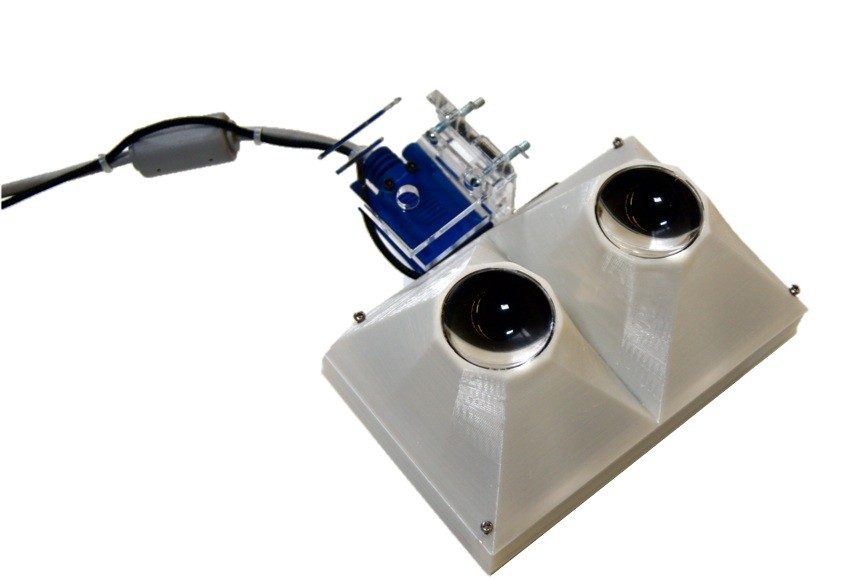The University of Southern California’s ‘MxR’ Lab today launched an ‘open source’ DIY virtual reality website. The lab is making freely available many of their innovative virtual reality hardware and software projects. Users can download schematics to 3D print virtual reality hardware and follow the provided guides to put together head mounted displays and more. The lab is also making available several hardware modifications for the Oculus Rift which can be 3D printed, including a forward-facing stereo camera mount and an eyecup modification to allow users to get closer to the display.
The goal of the DIY VR site is to further the development of virtual reality by getting hardware and software freely into the hands of anyone that wants to build with it.
Build Your Own DIY VR Headset with 3D Printing
One of the projects available is the Socket HMD, a 90-degree field of view head mounted display which the Oculus Rift is largely based on. A housing for the Socket HMD, which has been employed by Project Holodeck, can be 3D printed with plans from the site. Instructions from the site tell you which additional components to purchase, and how to put the HMD together.
Oculus Rift Mods
Three interesting modifications for the Oculus Rift developer kit are also available:
The first of which is a mount that attaches to the front of the Rift. The mount makes it easy to attach stereo cameras, like the Microsoft Kinect, which can be used for optical tracking, spatial mapping, and more.
Second is an unofficial eye-cup which you can construct with 3D printing. The eye cup fits into the Oculus Rift and allows the user to get closer to the display, thereby increasing the field of view.
The third modification is a software utility that sends the Rift’s head-tracking data over a virtual reality peripheral network (VRPN) allowing other applications to make use of it.
VR2GO Smartphone HMD
The lab is also making available its VR2GO low-cost immersive viewer. This is a 3D printed HMD case in which you mount your smartphone, to utilize its display and motion sensors, to turn it into a low cost head mounted display. Currently VR2GO schematics are available for the iPhone 4/4S, iPhone 5, and iPod Touch (5th generation), though anyone is welcome to modify the existing design to fit other smartphones.
MxR Unit Package for Virtual Reality Development and FAAST
If the above wasn’t enough, the good folks at the MxR Lab are even offering up a custom Unity package full of scripts, scenes, and more to assist in virtual reality software development, especially for iOS and Android devices. With it you can quickly create stereoscopic 3D scenes, enable distortion, access smartphone sensor data, and more, all without having to write you own code from the ground up.
Furthmore, you can download the ‘Flexible Action and Articulated Skeleton Toolkit’ (FAAST):
FAAST is middleware to facilitate integration of full-body control with games and VR applications using either OpenNI or the Microsoft Kinect for Windows skeleton tracking software. FAAST includes a custom VRPN server to stream up to four user skeletons over a network, allowing VR applications to read the skeletal joints as trackers using any VRPN client. Additionally, the toolkit can also emulate keyboard input triggered by body posture and specific gestures. This allows the user add custom body-based control mechanisms to existing off-the-shelf games that do not provide official support for depth sensors.
You can see a prototype game based on FAAST in action here:
MxR’s Open Source Initiative
Mark Bolas and David Nelson of the USC’s MxR Lab are two of the folks behind this excellent DIY VR resource, which they are calling the “Open Source Initiative”
Bolas is the director of the MxR Lab as well as an Associate Professor at USC. Prior to MxR, he founded Fakespace Labs which made the famous Wide5 head mounted display (an impressive but cost-prohibitive unit). He spends much of his time at the lab developing hardware and software to enable immersive virtual reality experiences. Previously we’ve seen him using perceptual illusions to create infinite virtual spaces. Bolas was also featured in the Oculus Rift Kickstarter video (a homage to the origins of the Rift in the MxR Lab, and Bolas’ involvement in project) noting that “the Rift is taking years of virtual reality research and putting it into a package that everyone can use.”
“We went open, because it was the only way to truly disrupt the HMD marketplace. We believe it has just gotten started and can not wait for people to take all these designs we have on our site to see what they will do with them,” Bolas said about the open source initiative.
David Nelson is the Special Project Manager of the MxR Lab and has a background in narrative and documentary film production. He keeps projects on track and helps manage the lab.
Bolas and Nelson are attending the IEEE VR conference this week in Orlando, Florida and have a 3D printer on hand to print hardware for attendees and showcase the newly open sourced projects.
In addition to pushing to get these projects into the hands of the public, both have made significant contributions to the projects that you’ll find on the site. Go check it out!













